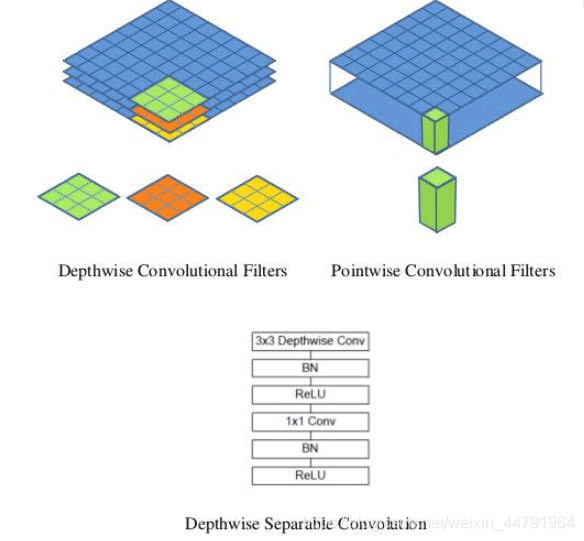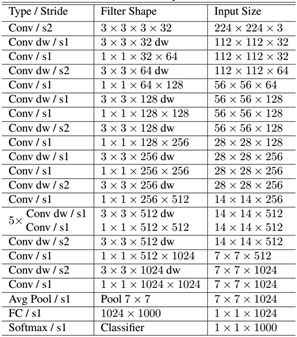什么是MobileNet模型
MobileNet是一种轻量级网络,相比于其它结构网络,它不一定是最准的,但是它真的很轻
MobileNet模型是Google针对手机等嵌入式设备提出的一种轻量级的深层神经网络,其使用的核心思想便是depthwise separable convolution。
对于一个卷积点而言:
假设有一个3×3大小的卷积层,其输入通道为16、输出通道为32。具体为,32个3×3大小的卷积核会遍历16个通道中的每个数据,最后可得到所需的32个输出通道,所需参数为16×32×3×3=4608个。
应用深度可分离卷积,用16个3×3大小的卷积核分别遍历16通道的数据,得到了16个特征图谱。在融合操作之前,接着用32个1×1大小的卷积核遍历这16个特征图谱,所需参数为16×3×3+16×32×1×1=656个。
可以看出来depthwise separable convolution可以减少模型的参数。
如下这张图就是depthwise separable convolution的结构

在建立模型的时候,可以使用Keras中的DepthwiseConv2D层实现深度可分离卷积,然后再利用1x1卷积调整channels数。
通俗地理解就是3x3的卷积核厚度只有一层,然后在输入张量上一层一层地滑动,每一次卷积完生成一个输出通道,当卷积完成后,在利用1x1的卷积调整厚度。
如下就是MobileNet的结构,其中Conv dw就是分层卷积,在其之后都会接一个1x1的卷积进行通道处理,

MobileNet网络部分实现代码
|
1
2
3
4
5
6
7
8
9
10
11
12
13
14
15
16
17
18
19
20
21
22
23
24
25
26
27
28
29
30
31
32
33
34
35
36
37
38
39
40
41
42
43
44
45
46
47
48
49
50
51
52
53
54
55
56
57
58
59
60
61
62
63
64
65
66
67
68
69
70
71
72
73
74
75
76
77
78
79
80
81
|
#-------------------------------------------------------------## MobileNet的网络部分#-------------------------------------------------------------#import warningsimport numpy as npfrom keras.preprocessing import imagefrom keras.models import Modelfrom keras.layers import DepthwiseConv2D,Input,Activation,Dropout,Reshape,BatchNormalization,GlobalAveragePooling2D,GlobalMaxPooling2D,Conv2Dfrom keras.applications.imagenet_utils import decode_predictionsfrom keras import backend as Kdef MobileNet(input_shape=[224,224,3], depth_multiplier=1, dropout=1e-3, classes=1000): img_input = Input(shape=input_shape) # 224,224,3 -> 112,112,32 x = _conv_block(img_input, 32, strides=(2, 2)) # 112,112,32 -> 112,112,64 x = _depthwise_conv_block(x, 64, depth_multiplier, block_id=1) # 112,112,64 -> 56,56,128 x = _depthwise_conv_block(x, 128, depth_multiplier, strides=(2, 2), block_id=2) # 56,56,128 -> 56,56,128 x = _depthwise_conv_block(x, 128, depth_multiplier, block_id=3) # 56,56,128 -> 28,28,256 x = _depthwise_conv_block(x, 256, depth_multiplier, strides=(2, 2), block_id=4) # 28,28,256 -> 28,28,256 x = _depthwise_conv_block(x, 256, depth_multiplier, block_id=5) # 28,28,256 -> 14,14,512 x = _depthwise_conv_block(x, 512, depth_multiplier, strides=(2, 2), block_id=6) # 14,14,512 -> 14,14,512 x = _depthwise_conv_block(x, 512, depth_multiplier, block_id=7) x = _depthwise_conv_block(x, 512, depth_multiplier, block_id=8) x = _depthwise_conv_block(x, 512, depth_multiplier, block_id=9) x = _depthwise_conv_block(x, 512, depth_multiplier, block_id=10) x = _depthwise_conv_block(x, 512, depth_multiplier, block_id=11) # 14,14,512 -> 7,7,1024 x = _depthwise_conv_block(x, 1024, depth_multiplier, strides=(2, 2), block_id=12) x = _depthwise_conv_block(x, 1024, depth_multiplier, block_id=13) # 7,7,1024 -> 1,1,1024 x = GlobalAveragePooling2D()(x) x = Reshape((1, 1, 1024), name='reshape_1')(x) x = Dropout(dropout, name='dropout')(x) x = Conv2D(classes, (1, 1),padding='same', name='conv_preds')(x) x = Activation('softmax', name='act_softmax')(x) x = Reshape((classes,), name='reshape_2')(x) inputs = img_input model = Model(inputs, x, name='mobilenet_1_0_224_tf') model_name = 'mobilenet_1_0_224_tf.h5' model.load_weights(model_name) return modeldef _conv_block(inputs, filters, kernel=(3, 3), strides=(1, 1)): x = Conv2D(filters, kernel, padding='same', use_bias=False, strides=strides, name='conv1')(inputs) x = BatchNormalization(name='conv1_bn')(x) return Activation(relu6, name='conv1_relu')(x)def _depthwise_conv_block(inputs, pointwise_conv_filters, depth_multiplier=1, strides=(1, 1), block_id=1): x = DepthwiseConv2D((3, 3), padding='same', depth_multiplier=depth_multiplier, strides=strides, use_bias=False, name='conv_dw_%d' % block_id)(inputs) x = BatchNormalization(name='conv_dw_%d_bn' % block_id)(x) x = Activation(relu6, name='conv_dw_%d_relu' % block_id)(x) x = Conv2D(pointwise_conv_filters, (1, 1), padding='same', use_bias=False, strides=(1, 1), name='conv_pw_%d' % block_id)(x) x = BatchNormalization(name='conv_pw_%d_bn' % block_id)(x) return Activation(relu6, name='conv_pw_%d_relu' % block_id)(x)def relu6(x): return K.relu(x, max_value=6) |
图片预测
建立网络后,可以用以下的代码进行预测。
|
1
2
3
4
5
6
7
8
9
10
11
12
13
14
15
16
|
def preprocess_input(x): x /= 255. x -= 0.5 x *= 2. return xif __name__ == '__main__': model = MobileNet(input_shape=(224, 224, 3)) img_path = 'elephant.jpg' img = image.load_img(img_path, target_size=(224, 224)) x = image.img_to_array(img) x = np.expand_dims(x, axis=0) x = preprocess_input(x) print('Input image shape:', x.shape) preds = model.predict(x) print(np.argmax(preds)) print('Predicted:', decode_predictions(preds, 1)) |
预测所需的已经训练好的Xception模型可以在https://github.com/fchollet/deep-learning-models/releases下载。非常方便。预测结果为:
|
1
|
Predicted: [[('n02504458', 'African_elephant', 0.7590296)]] |
以上就是python神经网络MobileNet模型的复现详解的详细内容,更多关于MobileNet模型复现的资料请关注服务器之家其它相关文章!
原文链接:https://blog.csdn.net/weixin_44791964/article/details/102819915








